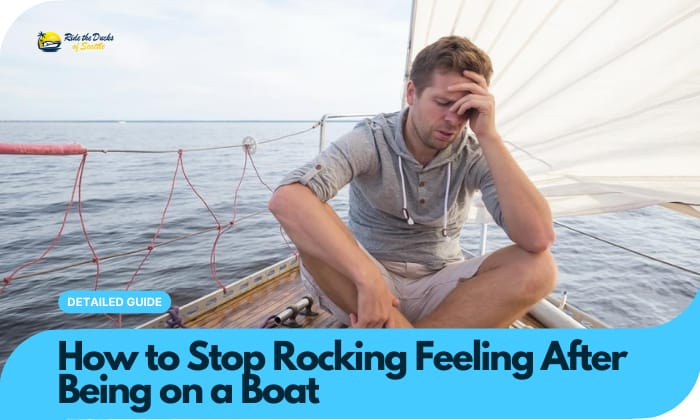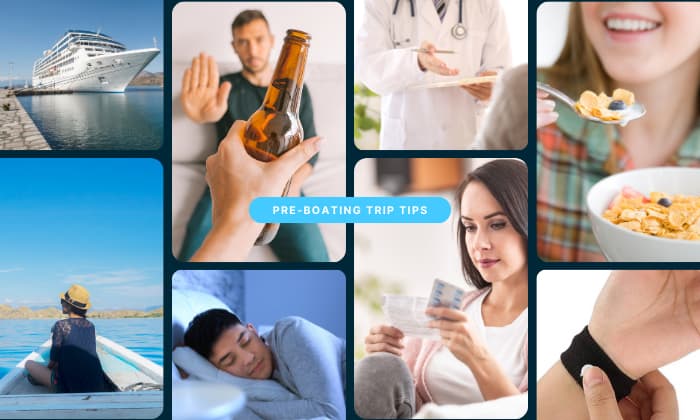Going on a cruise or having a splendid time boating is an experience like no other. Unfortunately, land sickness and sea legs can spoil the reliving of memories several days after the trip. So, how to stop rocking feeling after being on a boat becomes a must-learn for any greenhorn cruiser.
Thankfully, there are proven ways to get rid of motion sickness after a cruise or boating adventure. Please continue reading to learn different techniques to get undizzy and ensure steady legs. Let’s start.
Table of Contents
Step-by-step to Stop Rocking Feeling After Being on a Boat
What to prepare
Understanding land sickness after cruise symptoms and why they occur is crucial to get rid of rocking vertigo and sea legs. Hence, we recommend reading what you can about vertigo or motion sickness or asking your family doctor about it.
What to do
Here are some motion sickness after cruise treatment or management approaches you can consider to get rid of sea legs and associated symptoms.
According to the US Centers for Disease Control and Prevention, motion sickness occurs because the signals received by the inner ears differ from the movements the eyes see.
We vomit, feel nauseous, or experience dizziness after cruise because the body is still adjusting to land-based sensations. We can help the body stabilize different sensory inputs by resting.
So, how do we manage “land sickness?” Lie down on the bed or couch and try to refrain from doing unnecessary movements. This technique stabilizes fluid movement in the inner ears, allowing you to stop feeling like you’re on a boat when you’re not.
You could also try relaxation techniques, including meditation, deep-breathing exercises, and taking a nap. Anxiety and lack of sleep can exacerbate extreme fatigue after cruise, worsening land sickness symptoms.
Assisting the vestibular system to return to normal functioning is key to helping you stop feeling you’re on a boat fast. You can exercise the eye, head, neck, and shoulder muscles before proceeding to the rest of the body.
- Look at a fixed object in the room and start moving your eyes up and down for about 10 seconds before returning your sight to the target item.
- Repeat the eye exercises by moving them left (or right), holding them for 10 seconds, and returning to the fixed object.
- Perform the same maneuver but move your head and neck up, down, and side to side instead.
- Look forward, extend one arm in front, and point the index finger upward. Fix your eyes on the finger and slowly move the finger toward you, maintaining eye contact with it at all times.
- Perform shoulder rolls to help improve land sickness symptoms after being on boat.
Water might not cure land sickness after cruise, but it can help the body recover faster. Good, ol’ fashioned drinking water doesn’t have an irritating smell or unpleasant taste, avoiding flooding the brain with unnecessary sensations.
Water also brings the much-needed nutrients and substances essential for your recovery from sea sickness after getting off boat.
On that note, please refrain from drinking alcoholic beverages. If you must drink something other than water, we recommend carrot or apple juice. You could also try a clear soup, but steer clear of coffee and milk.
The first time I went on a cruise, I still feel like I’m on a boat 2 days later. And I’m sure some newbie cruisers have similar experiences.
This technique might seem counterintuitive, but it works. Our brain thinks we’re still moving. Hence, you can “trick” it into thinking you’re still on a boat.
You can drive your car slower than usual or have someone drive you. Take your bike to the park or walk several blocks around the neighborhood. Of course, you might want to check your wobbly sea legs on land before doing these activities.
Greasy and heavy meals are never a sea legs cure. Foods rich in spices can flood the brain with different sensations, further aggravating land sickness symptoms.
Moreover, acidic and fatty foods can overwork the stomach, making you more prone to nausea and vomiting.
Go for smaller feeding portions of low-fat, bland foods. You can take crackers, bananas, ginger, or apples. Unseasoned nuts can also help mitigate nausea and dizziness, allowing you to recover from sea legs after cruise faster.
Although continuing to move (i.e., driving, walking, and biking) can help minimize swaying after cruise, please be more cautious in head movements.
Experts at the Baylor College of Medicine explain that folks with “mal de debarquement” should avoid vigorous physical activities (including exercises) involving the head.
Hence, head-shaking, jogging, running, and dancing are a no-no if you are still dizzy after cruise. Doctors also don’t recommend long rides.
It’s worth remembering that sudden movements can worsen land sickness symptoms. And that’s why we recommended light exercises only for the eyes, head, and neck.
A visit to the physician might be necessary if none of the above methods work and the symptoms persist several days after the trip.
Feeling seasick after cruise shouldn’t last more than a couple of days, with most folks experiencing sea legs for only several minutes after disembarkation.
Over-the-counter medications (i.e., Benadryl or Dramamine) often work to minimize motion and land sickness symptoms. Other doctors might use more powerful drugs, like Valium.
If these don’t work, your doctor might recommend Vestibular Rehabilitation Therapy (VRT), including exercises to help brain motion processing.
Boat Motion Sickness
We hear many puzzled folks who ask, “Can being on a boat trigger vertigo?” Unfortunately, boating can “activate” such a condition. Medical experts label it “mal de debarquement syndrome.”
The condition results from natural brain processes integrating sensory inputs from the eyes and ears (for balance). The brain adjusts to the visual and vestibular sensations when we go on a boating trip. That’s why we don’t feel dizzy and nauseous after some time.
Mal de debarquement occurs when the brain cannot “reprogram” or “erase” the memory of on-the-boat sensations after the trip. Hence, we feel persistent feelings of swaying, rocking, or being off balance after disembarkation. There might be nausea, dizziness, and vomiting, too.
The good news is the condition only lasts a maximum of two days, although most will continue feeling dizzy after a cruise for only a couple of minutes to several hours.
Preventive Measures for Motion Sickness
The following pre-boating trip tips should help you avoid unpleasant motion sickness.
- Choose larger ships because they are more stable, even in choppy waters. It might also be wise to study the cruise route, ensuring the vessel only travels in calm waters.
- Try booking a cabin in the ship’s midsection to minimize the impact of vessel rolls and seesaws. A view of the horizon can also give the eyes a reference point, helping mitigate motion sickness.
- Reflect on your experiences, focusing on things that made you nauseous. Avoid them as much as possible, including alcohol and smoking.
- Have a good night’s rest and sleep before traveling.
- Talk to your physician about antiemetics, including how to take them. Drink the medication according to instructions, preferably before the voyage.
- Eat light before the trip to avoid upsetting the stomach and increasing the risk of boat motion sickness.
- Consider non-traditional anti-nausea management techniques, including acupressure wristbands.
Frequently Asked Questions
What other medications can I take to prevent or cure land sickness?
We don’t recommend taking any medications without consulting your physician. On that note, some doctors recommend Ginkgo biloba and Vitamin B supplements to manage severe travel sickness. Some might prescribe a mild sedative to calm you.
Is eating ginger root effective in preventing seasickness?
A meta-analysis of six studies revealed that ginger doesn’t show a significant advantage over placebo in preventing seasickness, chemotherapy-induced nausea, and morning sickness. However, these studies favored ginger, reinforcing anecdotal evidence of its effectiveness.
Although the scientific findings are inconclusive, you can always take a thumb-sized ginger root and eat it like candy. Ginger improves digestion and immune system functioning while relieving nausea and associated symptoms.
Even if ginger doesn’t treat sea legs, you’ll still come out as a winner.
Conclusion
You have seven proven options for how to stop rocking feeling after being on a boat. We recommend starting with a complete rest and complementing it with light exercises for the eyes, head, and neck. You could also go easy on heavy meals and avoid alcohol and other stimulants.
Sea legs and land sickness aren’t fatal, although disturbances in balance can increase the risk of falls and other accidents.
If your after-cruise experiences are severe enough to warrant vestibular rehabilitation therapy or more aggressive treatments, you might want to avoid going on a cruise anytime soon.

Ten years of enjoying countless trips on boats never made me love them any less! So I am here to put all those experiences into good use for other boaters who want to have a safe and fun trip with their friends and families.













